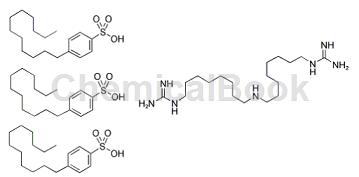Background[1]
Biguanide trioctyl benzene sulfonate, chemical name: 1,1-octylmethylene biguanide trioctyl phenyl sulfonate. It is a new biguanide fungicide developed by Nippon Ink Chemical Industry Co., Ltd. Its dosage form is 40% wettable powder with an average molecular weight of 1335.05. Its chemical name is (1,1′-iminodioctylmethylene) trialkyl phenyl sulfonate biguanide. Biguanide trioctyl benzene sulfonate is a broad-spectrum, low-toxic fungicide that inhibits bacterial lipids. Biosynthesis of quasi-compounds, strong local permeability, and high growth inhibitory activity against pathogenic Ascomycetes and Deuteromycetes. Biguanide trioctyl benzene sulfonate has good water solubility and thermal stability, is also relatively stable in acid and water, and is easily biodegradable.

Biguanide trioctyl benzene sulfonate
Apply[3]
Biguanide trioctyl benzene sulfonate 40% wettable powder can be widely used to prevent and control fungal diseases caused by most ascomycetes and deuteromycetes on fruits, vegetables, and gray mold, powdery mildew, and various crops. Diseases such as sclerotinia, vine blight, anthracnose, leaf spot and fruit soft rot.
1. Pesticide composition of biguanide trioctyl benzene sulfonate and mancozeb
The compound pesticide composition of biguanide trioctyl benzene sulfonate and mancozeb has good control effect on crop diseases caused by pathogenic Ascomycetes and Deuteromycetes, and provides crop protection, It provides dual care and can delay the development of drug resistance. It has a long lasting effect, reduces the dosage and frequency of use, saves costs, is easy to use, saves time and labor, and is environmentally friendly.
Preparation method: biguanide trioctyl benzene sulfonate 25%, mancozeb 55%, sodium lauryl sulfate 6%, dispersant lignosulfonate 4%, disintegrant sodium chloride 2%, binder polyethylene glycol 3%, stable soluble starch 3%, kaolin supplemented to 100%. The above formula is dry-pulverized, granulated, dried and sieved in proportion to prepare 80% biguanide trioctyl benzene sulfonate·mancozeb water-dispersible granules.
2. Pesticide composition of biguanide trioctyl benzene sulfonate and fluazinam
It has a significant synergistic effect on rice sheath blight; it is safe for target crops, humans and animals, and the environment; it reduces the amount and frequency of applications, is easy to use, and reduces the cost of use. It has high efficiency, quick effect, and long lasting effect. advantage. Preparation method: biguanide trioctyl benzene sulfonate 15%, fluazinam 15%, sodium lignosulfonate 5%, calcium dodecylbenzene sulfonate 3%, xanthan gum 0.1%, dodecane Betaine 5%, glycerin 5%, gum arabic 0.1%. Make up to 100% with deionized water. The above formula is pre-pulverized in proportion, then added to a sand mill for grinding, and mixed with high shear to prepare 30% biguanide trioctyl benzene sulfonate fluazinam suspension.
3. Pesticide composition of biguanide trioctyl benzene sulfonate and chlorothalonil
Suitable for the prevention and control of wheat powdery mildew, strawberry powdery mildew, citrus penicillium, citrus sour rot, citrus anthracnose, cucumber downy mildew, rice sheath blight, rice blast, potato early blight, potato late blight, Crop diseases such as watermelon anthracnose.
Preparation method: 210 grams of biguanide trioctyl benzene sulfonate, 106 grams of chitosan, 35 grams of sodium lignosulfonate, 31 grams of sodium fatty acid ester sulfate, p-methoxy fatty acid amidobenzene 5.1 grams of sulfonic acid, 5.1 grams of fatty alcohol polyoxyethylene ether, 5.2 grams of glycerin, 1.1 grams of xanthan gum, and deionized water to make up to 1000 grams. Pre-pulverize the above formula in proportion, and then add it to a sand mill for grinding. After high-shear mixing, the biguanide trioctyl benzene sulfonate·chitosan suspension was prepared. After testing, the biguanide trioctyl benzene sulfonate content was 20.2% and the chitosan content was 10.2%. Total effective content 40.4%.
Mechanism of action
Mainly acts on the synthesis of steroid compounds and cell membrane function of pathogenic bacteria, inhibiting spore germination, germ tube elongation, attachment robes and hyphae formation. It has strong local permeability. It is a contact and preventive fungicide; biguanide triglyceride Octylbenzene sulfonate has a wide bactericidal spectrum and is used to prevent and control diseases caused by ascomycetes and deuteromycetes. It also has a good control effect on diseases that occur during citrus storage. It can also make the fruit surface bright and increase the value of the product. .
Main reference materials
[1] Zou Weibin, Feng Xiu���, Dong Rusheng, Liu Yan, & Mao Yuhua. (2012). High performance liquid phase quantitative analysis of biguanide trioctyl benzene sulfonate 40% wettable powder. Pesticide Science and Management, 33(1), 35-38.
[2] Du Xiaolei, Hu Tongle, & Cao Keqiang. (2014). Indoor toxicity determination of 40% biguanide trioctyl benzene sulfonate wettable powder against apple spotted leaf disease. 2014 Academic Journal of China Plant Protection Society Proceedings of the annual meeting.
[3] Song Xiaobing. (2015). Control effect of pyraclostrobin·biguanide trioctyl benzene sulfonate on postharvest penicilliosis in sweet orange. Tropical Agricultural Science, 35(8), 59- 62.

 微信扫一扫打赏
微信扫一扫打赏

